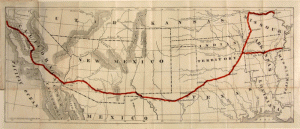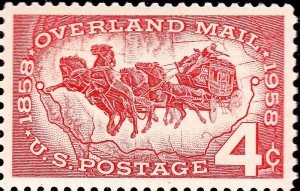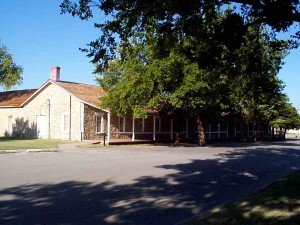It’s not easy to find the site of an old Butterfield Stage station these days. The Butterfield stagecoach stations simply disappeared over the years but there is one remaining site located in southern California on the historic Butterfield trail.
Thank you for reading this post, don't forget to subscribe! This is the Oak Grove Butterfield Stage Station located in Warner Springs California, about 50 miles east of Oceanside and 125 miles southeast of Los Angeles, and has the distinction of being the only surviving station on the old Butterfield Overland Mail route. During the Civil War the station was used as a Union outpost to help protect the route eastward towards Fort Yuma. Visiting this restored Butterfield station brings back thoughts about what it would have been like riding a stagecoach over the remote southwest. It certainly would have been an adventure and one with a lot of risks. The following descriptions may give you a sense of what a journey of this kind in the late 1850’s might have entailed.
This is the Oak Grove Butterfield Stage Station located in Warner Springs California, about 50 miles east of Oceanside and 125 miles southeast of Los Angeles, and has the distinction of being the only surviving station on the old Butterfield Overland Mail route. During the Civil War the station was used as a Union outpost to help protect the route eastward towards Fort Yuma. Visiting this restored Butterfield station brings back thoughts about what it would have been like riding a stagecoach over the remote southwest. It certainly would have been an adventure and one with a lot of risks. The following descriptions may give you a sense of what a journey of this kind in the late 1850’s might have entailed.
A few years b
 Similar to other new means of transportation, the start was typically with a government mail contract. With the California Gold Rush in progress and with the state itself joining the Union in 1850, communication with the west coast was more important than ever. Remember, this was an era before the transcontinental railroad and before the telegraph lines to California. As an example, in the 1850’s it generally took about 45 days for a letter to make it’s way from San Francisco to New York. The route for that letter would have been a steamer from San Francisco to Panama and then through the jungles of Panama to another steamer on the eastern side of the Isthmus. Quite a journey.
Similar to other new means of transportation, the start was typically with a government mail contract. With the California Gold Rush in progress and with the state itself joining the Union in 1850, communication with the west coast was more important than ever. Remember, this was an era before the transcontinental railroad and before the telegraph lines to California. As an example, in the 1850’s it generally took about 45 days for a letter to make it’s way from San Francisco to New York. The route for that letter would have been a steamer from San Francisco to Panama and then through the jungles of Panama to another steamer on the eastern side of the Isthmus. Quite a journey.
The Butterfield Stage route from St Louis would shorten the time somewhat. What is generally described as a twenty-five day trek from St’ Louis to San Francisco was along what was called the southern route. The route went through Arkansas, Texas, present day New Mexico and Arizona into the San Diego area and the northward to San Francisco. To say the journey was adventuresome would be an understatement. All research on the subject I have done pretty much points to the mail itself as being the top priority. After all, the government mail contract was the financial seed to begin the stage line in the first place. Carrying passengers along the route was important but somehow secondary. The Butterfield Overland Stage Line began operation in 1858. The first westbound stage made it to Springfield September 17, 1858, some three hours ahead of schedule. The first eastbound stage arrived in Springfield on October 22, 1858 That stage was carrying five passengers, along with mail, freight, and express parcels. Below is a picture of the Fort Stockton Texas barracks from the 1800’s. Fort Stockton was directly on the Butterfield Stage route in southwest Texas.
 There are interesting stories about the people who rode the Butterfield Stage route and their observations are enlightening. Many of these journey’s were anything but boring. In fact, the Butterfield Stage Line ran through Arizona during the long Apache Wars. Many of it’s stages were attacked near the Dragoon Mountains not far north of Tombstone Arizona where Cochise had his stronghold. Riding through Arizona in the 1860’s and 1870’s would be anything but boring. The first question you might ask is: What should I bring along? A reporter for the San Francisco Evening Bulletin who rode the route in 1858 was quoted in his article “All the traveler needed to render himself comfortable is a pair of blankets, a revolver or knife (just as he fancies), an overcoat, some wine to mix with the water (which is not of the sweeetest quality) and three or four dollars worth of provisions”. he went on to say that “Arms are not furnished the passengers by the Company”.
There are interesting stories about the people who rode the Butterfield Stage route and their observations are enlightening. Many of these journey’s were anything but boring. In fact, the Butterfield Stage Line ran through Arizona during the long Apache Wars. Many of it’s stages were attacked near the Dragoon Mountains not far north of Tombstone Arizona where Cochise had his stronghold. Riding through Arizona in the 1860’s and 1870’s would be anything but boring. The first question you might ask is: What should I bring along? A reporter for the San Francisco Evening Bulletin who rode the route in 1858 was quoted in his article “All the traveler needed to render himself comfortable is a pair of blankets, a revolver or knife (just as he fancies), an overcoat, some wine to mix with the water (which is not of the sweeetest quality) and three or four dollars worth of provisions”. he went on to say that “Arms are not furnished the passengers by the Company”.
Another journalist by the name Waterman L. Ormsby rode with the first Butterfield Stage heading west on September 16, 1858. Ormsby, a 23-year-old reporter for the New York Herald on this historic first run. Ormsby reported that mules were used to pull the stage coaches over the frontier portions of the route because, to Indians, the mules were considered less valuable than horses as property. Ormsby goes on to say that one team of mules had been trained to come to feed at the sound of a large gong. The stage driver, or sometimes referred to as a “whip”, planned to use the gong to call the mules back in case the Indians managed to steal them. Ormsby described that it took about 30 minutes to harness each mule and he was quoted as saying… “By the time a mule was caught and harnessed, often nearly choked to death, he was almost always nearly tired out before his work had commenced.”
If you thought the seating arrangement inside the Concord coach was a benefit, here is what it looked like. Passengers rode three abreast. There were two back rows facing forward and a front row facing backwards. Your luggage would sometimes be on your lap and U.S. Mail would likely be under your seat. This arrangement might make your seat on today’s jetliner seem pretty roomy. The stagecoach ran day and night with only short stops at stations for what most described as fairly poor food.
Also, realize that a passenger essentially had about three times to bathe while on the Butterfield route. While there were plenty of Butterfield stations not many of them had the necessary facilities. Sleeping was another challenge. passengers slept in the Concord coach while it was on it’s bumpy ride. It’s been reported that it took most passengers about a week to become accustomed to sleeping while traveling. Sleep during the first week was near impossible but after getting a bit acclimated to the ride things got a lot better. Here is a description of the sleeping situation as described by an English passenger on the eastbound Butterfield route in 1860. The passenger was quoted describing the posture necessary to sleep in a moving stagecoach … “sometimes slinging our feet by loops from the top of the wagon, or letting them hang over the sides between the wheels . . . and not seldom nodding for hours together in attitudes grotesque and diverse.”
If you find your self on a southern California vacation and you’re staying at Los Angeles hotels or hotels in San Diego and have a rental car, a stop at the famous Oak Grove Butterfield Stage station makes for a fun and historic addition to your travel itinerary.

